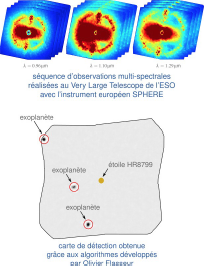The observation of extra-solar planetary systems (planets orbiting stars other than our sun) is a recent revolution in astronomy.
Almost 99% of exoplanets have been detected by indirect methods, analyzing the motion of the host star in gravitational interaction with the exoplanet(s).
Direct imaging aims to produce an image of the star’s immediate environment, enabling the detection and characterization of exoplanets or dust disks typical of planetary systems in formation. This is a real technological challenge, due to the very small angular separation between the star and its planetary system (requiring very high angular resolution) and the formidable contrast between the star and the exoplanets (in the infrared, a young Jupiter-type exoplanet is about a million times less bright than its sun, while a large telluric planet is about a billion times less bright).
The two best-performing direct imaging systems today, the European SPHERE instrument and the American GPI instrument, combine a large telescope (8m in diameter), dynamic correction of the effects of atmospheric turbulence (adaptive optics) and a differential imaging observation strategy (acquisition of a sequence of images in which slight variations in the signal of interest facilitate its detection).
In collaboration with the Lyon Observatory, a doctoral student and a teacher-researcher at Télécom Saint-Etienne have developed algorithms for detecting exoplanets with unrivalled sensitivity. Their methods are based on recent data science techniques, in particular modeling and statistical learning of the spatial structure of signal fluctuations. The software developed has since been applied to analyze data collected during hundreds of nights of observation at Chile’s Very Large Telescope, enabling the reconstruction of exoplanet trajectories along their orbits or the characterization of their spectra.
